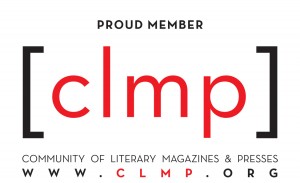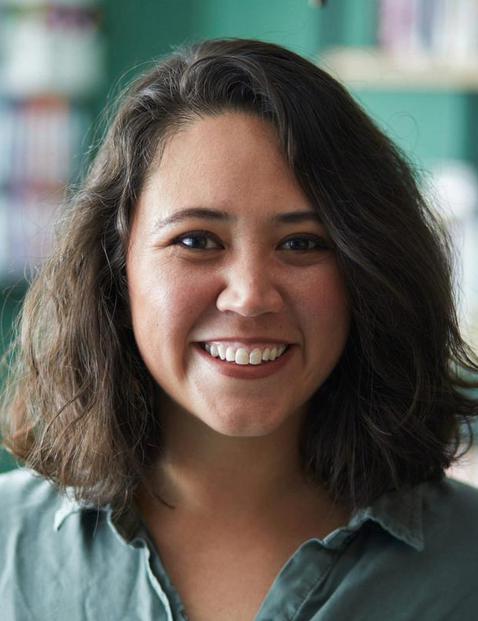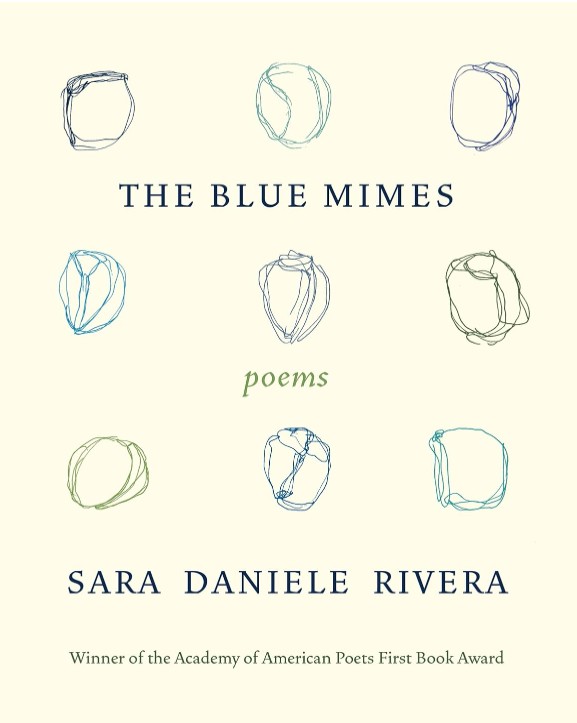Karen Sherk Chio Speaks with Sara Daniele Rivera
Sara Daniele Rivera is a Cuban Peruvian American artist, writer, translator, and educator. Her writing has appeared in The BreakBeat Poets Vol. 4: LatiNext, Solstice, Waxwing, Speculative Fiction for Dreamers: A Latinx Anthology, and elsewhere. She was the recipient of a 2017 St. Botolph Club Emerging Artist Award, the winner of the 2018 Stephen Dunn Prize in Poetry (Solstice Magazine), and a 2022 Tin House resident. She is a co-translator of The Blinding Star: Selected Poems by Blanca Varela (Tolsun Books, 2021) and co-editor of Not Your Papi’s Utopia: Latinx Visions of Radical Hope (Mouthfeel Press, 2025). Her debut book of poetry, The Blue Mimes (Graywolf Press, 2024), won the 2023 Academy of American Poets First Book Award. She lives in Albuquerque, New Mexico.
KSC: How long did it take you to create your perspicacious debut poetry collection The Blue Mimes? What was the process of creating and publishing it like for you?
SDR: I worked on The Blue Mimes for nine years. It took root in 2014 when I visited Lima for the first time since childhood after my grandfather passed away, during the progression of my grandmother’s Alzheimer’s. In 2020 I would lose my remaining living grandparents to the pandemic; in 2017, I unexpectedly lost my dad, and also had friends in those years who died too young. My book is, at its heart, elegiac, a way of holding these losses while also interrogating the voids, absences, and disjuncture I felt radiating in my sense of self: the stories lost to my family’s migration and assimilation, the things no one talked about, the wounds that manifest in silence. I also wrote into the communal grief of watching mass shootings and police violence come to a head in my country, wrote to process the pandemic, the rise of far-right extremism, and family separations and militarized deportations at the U.S.-Mexican border.
I submitted the book for about five years in different forms but didn’t submit it very widely. I wrestled with it. The structure changed often; I changed the poem ordering radically three days before I submitted it for the award it won. But from the first draft that started to come together, I believed there was something in it. That belief carried it through various stages of rejection until I had the luck of finding others who believed in it too.
KSC: The Blue Mimes is full of bilingual (Spanish and English) poems. Beyond employing two languages, many poems center the concept of language. I was particularly taken by the prose poem “Abrigar,” which is organized into parts that each reflect upon a definition and translation of this multifaceted transitive verb (which means to bundle, to shelter, to protect, and to harbor, depending on its use). Throughout the poem, language does so much: makes and contracts space, becomes memory, defends and protects. How has bilingualism shaped your approach to writing? What are the many ways the idea of translation shows up in your work, literally and figuratively?
SDR: My family’s bilingualism was formative to my understanding of language. My parents always moved between Spanish and English fluidly; the boundary between languages in our home was beautifully porous. I want my multilingual writing to capture the mechanisms and possibilities of the multilingual mind, the way it migrates between linguistic registers or presses languages together to create meaning. The way one language will spring forward because of its emotional or lyric quality. I wrote “Abrigar” as a kind of “untranslatable word” poem: I never felt there was an analog in English that captured its mix of practicality and tenderness.
In my poem “Someone curls into themselves”, translation acts as a mirror; I placed the poem on the page across from its translation and was interested in the physical gulf created between two echoing texts. In the editing process, echoing and mimicry became a structural force in my book: there are many paired poems, and in earlier drafts I kept these pairs together, but my editor pushed me to fracture them apart, to see how they call out to one another when strewn throughout the book. That separation made their dialogue more dynamic. I think of translation and multilingual transitions in the book as having a similar dynamism: I was looking for moments of collision, of quiet echoing, of traveling an intangible road between two shades of one meaning. The title poem, “The Blue Mimes / Los mimos azules”, begins in English, then goes back in time and gradually blossoms toward Spanish, then arrives back where it begins, the same words now in Spanish. The braiding and transition of languages in that poem opened my mind to what I could do throughout the rest of the book.
There are other ways in which translation shows up in my work. Like the moments when the constructions or diction of writers I’ve translated enter my voice. Or the decision I made never to translate my Spanish through footnotes/embedded hints/end notes, which is a matter of audience, and the fact that I write primarily for a Latinx diaspora.
KSC: Your poetry is in conversation with and responds to a diversity of artists, including Argentine poet Alejandra Pizarnik, who was herself a poet, translator, and studied visual art. How has her work influenced yours? I know that silence figures prominently in her work. How do you approach silence in your poetry?
SDR: I read Pizarnik in grad school and became quickly obsessed. Hers was the first work I ever translated for my class assignments (I don’t have the rights to publish these translations), and so it was the first work I experienced that intimate dialogue with. I hadn’t grown up reading much poetry from my parents’ countries and had rarely been taught the work of Latin American writers other than the usual suspects: Paz, Borges, Neruda, Cortázar, Allende. I arrived at my graduate program having read very few women poets writing in Spanish. When I read Pizarnik, I was struck by her interiority. Her writing wandered into archetypal gardens, held dark and mythic considerations of the violence of girlhood, practiced a malleability of genre and deep consideration of silence. I heard aspects of my own voice reflected back at me. Pizarnik allowed silence to live at the center of a poem, so that all of the language and craft choices funneled toward an absence, a wound keenly felt.
In poetry silence can be a matter of linguistic craft: the internal pause of the caesura, how a small chasm of white space can alter a line, how a line break can tumble us into quiet, how the visual silencing of an erasure poem can feed a thematic core. A text like Nicole Sealey’s The Ferguson Report is a masterwork of erasure, of using the silencing of text to reveal the conditions of racialized violence. Diana Khoi Nguyen’s Ghost Of is extraordinary in the way it employs visual chasms in its interrogation of grief. How do we approach aspects of our lives, our memories, that are unsayable or inarticulate? How do we render in language what exists in the world as silence? Where do we locate silence? I return often to Marie Howe’s reflections on the subject, how she has spoken about writing into silence, silence as a space that can be inhabited.
I’m very influenced by poets who engage with the political dimensions of silence. I love the work of Dunya Mikhail, and how she has spoken about creating poetry under censorship, developing figurative sensibilities in order to say things indirectly. She, like many others, has navigated the tensions and spectrums of silence: what it means to stay silent or be silenced, what consequences follow, and how we as poets respond to forces trying to eradicate our voices and histories.
KSC: Your poems are weighty with a love of family and a grief as its counterpoint. “Birdsongs” is particularly poignant as the speaker addresses their beloved late father, stating “I am past and present tense when they resist clear delineation, there and here, sells and sold.” You are particularly adept at writing about grief in a way that never bleeds into sentimentality. How do you approach grief in your art?
SDR: I try to approach grief with as much honesty and clarity as I’m capable of. I’ve felt fragmented, formless, and isolated when grieving; poetry is a space where I can explore the potential of language to fragment, shift form. It has given me spaces where I can hold the contradictions of grief, the way it lives alongside love. How it can be a communal or shared experience while also being extremely internal and lonely, because only you really know the world you’ve lost. I try to write toward these contradictions, which reflect so much the condition of being human.
KSC: The Blue Mimes includes many time markers, whether that’s poems dated during the COVID pandemic or references to U.S. election outcomes and ICE. In what ways do you see The Blue Mimes as a product of the period in which it was written and in what ways does the collection transcend its position in time?
SDR: So much of what is happening in the US right now is rooted, in a very direct way, in the time frame of the book, while also being rooted deeper in our country’s colonial, imperial, and capitalist origins. We can see the violence of those years unhinging now; I return to these poems and see those fracture lines forming and grieve what it has come to. Part of the current administration’s calculated attacks are directed towards archives, towards a sustained knowledge of our history that contradicts the golden mirage of the American dream. So, I believe that any documentation, however small, of a true moment or position in time, is valuable.
My main hope for this book was that, in holding my grief, it might meet someone else in theirs. I hope it continues to do this. I believe in the potential of those intimate connections.
KSC: I find your lineation and enjambment to be especially skillful. How do you approach deciding how and when to break a line? Or when to choose not to, as in the many prose poems in the collection?
SDR: I primarily play with line breaks in revision. I typically journal by hand, without breaks, then start applying breaks when I type up my drafts. The breaking point, the pausing point, the rhythmic and visual change, the manipulation of the poem’s pace, the suspension of meaning, the creation and disruption of patterns–these are only some of the aspects of the line break that make it one of my favorite craft tools to play with. While I, like most poets, have line lengths I tend toward and feel comfortable in (as Alberto Ríos says, the size of my step), the free-flowing alteration of line breaks often fuels my revision process. Changing them helps me literally re-see the poem, witnessing shifts in the relationship between visuality and theme. When I find the line breaks I want, it’s because the visual composition has arrived at a place of intentionality and meaning.
When I choose to write prose poems, I might be drawn to the continuous nature of the line and the way it builds momentum, or I might be drawn to the intimacy of a poem that resembles a small essay, fable, or diary entry. The serial prose poems in my book (“Abrigar” and “Birdsongs”) both started out as lineated pieces. I edited those early versions to death; the language was tight and polished, but I couldn’t feel the emotional core. A friend who read an earlier draft of “Abrigar” suggested that the stanzas were too restrained, too curated, that they were resisting something. She asked: “what if you broke them open?” That question led me to free-write and journal around each stanza, trying to understand for myself what I really wanted to say, and when I wrote the new draft I maintained the prose form that emerged in that process. It felt right for the scope of the poem, and it was messier, more unwieldy.
KSC: The landscape of the desert figures prominently in many of your poems. How does place influence your work?
SDR: There has always been an ecological strain to my work, particularly in my love for the desert ecosystem I grew up in. When I lived in Boston, I at times felt a displaced anxiety in the city, and when I landed back home in Albuquerque for the first time I realized it was because I couldn’t see the horizon. That expansion of space immediately calmed me. My family has been shaped in many ways by the wound of losing a homeland, so I try to approach every place I’ve lived with wonder and care, investing deeply in its people and land.
I was recently moved by the essay “Liminal Places” by Cuban artist Teresita Fernández. In it, she says: “Landscape is more about what you don’t see than what you do see. That struggle to find and clarify our coordinates has always been central to me…I developed a desire to invert the idea that the landscape is something outside of ourselves. In fact, we are amplified when we think of ourselves as an extension of the landscape…we become immense”. This speaks to the type of investment I hope to have in places, and to our responsibility as beings that are part of the earth, not separate from it. There’s something very grounding about the central questions of Fernández’s practice: anywhere she goes, she asks, where am I? Who am I in this place? And all of the complexities of place unfold from there. This is a space my work is entering now; I’m becoming more interested in interrogating the complexities of my relationship to place.
KSC: Which is your favorite poem in The Blue Mimes and why?
SDR: The title poem of the book is important to me because I’ve always felt like some key aspect of my voice began in that piece, as did my current process of mining poems from my journals. There are a few pieces that I’m particularly proud to have written: “Fields Anointed with Poppies” was written for a 2019 community vigil event commemorating the victims of the El Paso Walmart shooting, and it was a moment of synergizing my personal grief with communal grief, a moment of solidarity between two predominantly Latinx cities. The process of writing “Bird Sanctuary” is one I’ll always remember: I was in Miami to teach a workshop a little over a year after my dad passed away and visited his father’s grave in Little Havana. That evening I felt this poem kicking out of me with a force I’ve rarely felt, and it came out almost entirely in its current form. I’m proud of the dual act of unmasking and unmaking at the center of “Rompecabezas”, which came from a family story, or the lack of a story. A few years ago, my mom told me that my grandfather had twin older sisters who died before he was born. I’d never heard of them and no one still living in the family knew their names or could say exactly how they died. I became fixated on these lost girls, and tried to write short stories about them, but they felt so unknown to me that even that felt like an intrusion. So I wrote this poem towards the absence of their story, the capture the feeling of trying to hold a person who is disintegrating as you touch them.
KSC: You are an artist across multiple media—literature (poetry, fiction, translation), sculpture, and illustration (you drew the line illustrations included in The Blue Mimes). How do the many ways you create art intersect? Do you feel that they complement or inspire one another? Do they ever get in each other’s way?
SDR: I think of it as one arts practice with multiple materialities. They might gesture towards each other or offer different impulses or modes I can tap into. The multiplicity never feels like a barrier to me; it always feels like a source of opportunity. I like to joke that I’m ok at many things and not great at any single thing, meaning that, at least in my sculpture practice, I don’t have technical mastery over any single material. But I have enough multi-media proficiency to be able to call on different skills in my practice. I also love to work collaboratively and have come to value process as much as product; if I’m collaborating with members of my community to create an art installation, for example, the process of co-creation, of talking and writing together and skill sharing, is as much the artwork as the installation itself. There is artistic materiality in intangible things: sometimes the energy of coming together is enough.
KSC: What other projects are you working on these days? Do you have an artistic “dream project” you’d like to work on but have not yet had the opportunity to? If so, what is it?
SDR: I have a new translation project and am working on short stories and my novel. I’m happy to be in the early generative stages of poetry I’m working on, and some studio work I’m doing. I’m not focusing on the idea of another poetry manuscript right now, just enjoying new explorations.
I hope to continue using my translation practice to connect with poets, particularly in Peru and Cuba, whose are interested in reaching a US-based audience. I want to write a Gothic story set in the Southwest; I want to write about friendship. I have some early drafts of things for young readers (a children’s book, a YA novel) and would love to write a middle grade speculative series; writing for young readers is such a nuanced craft, one I’m eager to learn more about. Co-editing Not Your Papi’s Utopia: Latinx Visions of Radical Hope was a thoughtful, collaborative process, and I would love to have more opportunities to engage in that kind of editorial work.
__________________________________________________________________________________________________________________________________________________________________________
__________________________________________________________________________________________________________________________________________________________________________
__________________________________________________________________________________________________________________________________________________________________________
__________________________________________________________________________________________________________________________________________________________________________
© 2025 Iron Oak Editions
Stay Connected to Our Literary Community. Subscribe to Our Newsletter
August 19, 2025
Karen Sherk Chio (she/her) earned an MFA in poetry from the University of New Orleans, where she was the winner of the 2025 Andrea Saunders Gereighty/ Academy of American Poets Award, the 2025 Maxine and Joseph Cassin Prize for Poetry Thesis, and the 2023 Vassar Miller Poetry Award. She is also the winner of the 2025 James Applewhite Poetry Prize. Chio is an associate poetry editor for for West Trade Review, a full-time public health worker, a parent, and a spouse. Her creative work has appeared in swamp pink, Salamander, CALYX Journal, and SmokeLong Quarterly, among others, and her critical work has been published by the Colorado Review. She lives in Massachusetts.
__________________________________________________________________________________________________________________________________________________________________________
Listen to Rivera read "Abrigar" from her book The Blue Mimes (Graywolf, 2024)
Listen to Rivera read "Bird Sanctuary" from her book The Blue Mimes (Graywolf, 2024)
Listen to Rivera read "Rompecabezas" from her book The Blue Mimes (Graywolf, 2024)





